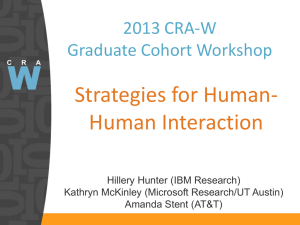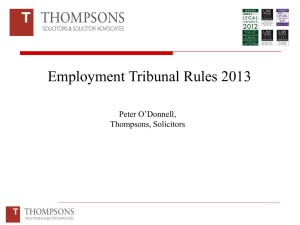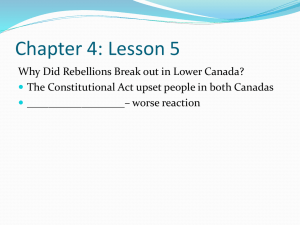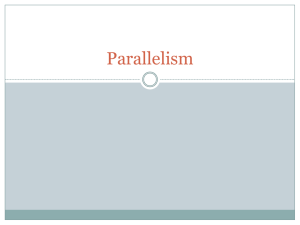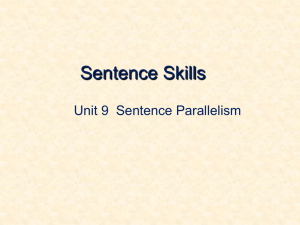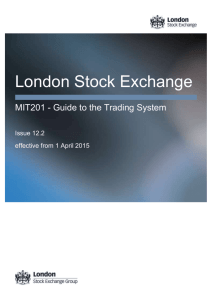Web Services Choreography Description Language (WS-CDL)
advertisement
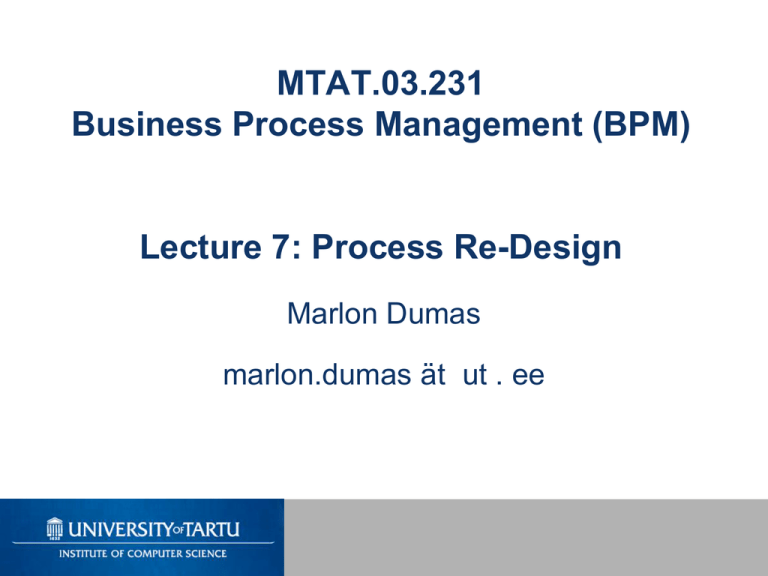
MTAT.03.231 Business Process Management (BPM) Lecture 7: Process Re-Design Marlon Dumas marlon.dumas ät ut . ee Where are we? 2 The Devil’s Quadrangle Costs Time Flexibility Quality (T+/-,Q+/-,C+/-,F+/-) 3 Design criterion 1: Time • Cycle time, including – service time (including set-up) – transport time (can often be reduced) – waiting time • Due to resource contention (limited capacity) • Due to external communication (waiting for client/partner) • Several ways to improve time properties: – – – – Improve average Improve variance Increase ability to meet due dates Increase perception of wait time 4 Design criterion 2: Quality • Product – Product meets specifications and/or expectations • Process, e.g. – Promises made to customers and (reasonable) customer expectations are met – Data and documents are handled correctly – Decisions made in the process are correct – Correct & timely information is provided to the customer 5 Design criterion 3: Cost • Type of costs – – – – fixed or variable per time unit, per use (consumable resources) processing, management, or support. human, system (hardware/software), or external, 6 Design Criterion 4: Flexibility • Ability to react to changes. • Flexibility of – resources (ability to execute many tasks/new tasks) – process (ability to handle various cases and changing workloads) – management (ability to change rules/allocation) – organization (ability to change the structure and responsiveness to demands of market or business partners 7 Process Redesign • Purpose: Identify possibilities for improving the design of a process: “as is” “to be” Descriprive modelling of the real world (as-is) Prescriptive modelling of the real world (to-be) • No silver-bullet: requires creativity • Redesign heuristics can be used to generate ideas 8 Re-Design Heuristics 1. Task elimination 2. Task composition 3. Triage 4. Resequencing 5. Parallelism 6. Process specialization and standardization 7. Resource optimization 8. Communication optimization 9. Automation 9 (1) Task Elimination • Sometimes "checks" may be skipped: trade-off between the cost of the check and the cost of not doing the check. (T+,Q-,C+/-) 10 (1) Task Elimination (cont.) • Other tasks to consider for elimination: – – – – – Print Copy Archive Store More generally: non-value adding activities • Task elimination can be achieved by delegating authority, e.g. – No need for approval if amount less than Y – Employees have budget for small expenses 11 Example Consider resubmission Purchase Request process rejected Check purchase request for 1st approval Purchase Request approved rejected Check purchase request for 2nd approval approved Send approved request to requestor Purchase Order process Make copy of purchase request Forward to purchase department Approved Purchase Request 12 (2) Task composition (merge or split) Pros: less work to commit, allows for specialization. Cons: setup time, fragmentation, less commitment. Pros of merging: setup reduction, no fragmentation, less transportation time, more commitment Cons of merging: more work to commit, one person needs to be qualified for both tasks being merged Splitting can be an opportunity to enable partial self-service, e.g. decouple scanning and payment in a supermarket (T+,F-) 13 Example Consider resubmission Purchase Request process rejected Check purchase request for 1st approval Purchase Request approved rejected Check purchase request for 2nd approval approved Send approved request to requestor Purchase Order process Make copy of purchase request Forward to purchase department Approved Purchase Request 14 (3) Triage • Consider dividing a general task into two or more alternative tasks or the integration of two or more alternative tasks into one general task. (T+,F-) 15 (4) Resequencing • • • • Order tasks based on cost/effect Put “knock-out checks” first – identify problems early Postpone expensive tasks until the end. In other words: order the tasks using the ratio “costs/effect”. (T+,C-) 16 Example Consider resubmission Purchase Request process rejected Check purchase request for 1st approval Purchase Request approved rejected Check purchase request for 2nd approval approved Send approved request to requestor Purchase Order process Make copy of purchase request Forward to purchase department Approved Purchase Request 17 (5) Parallelism • More parallelism leads to improved performance: reduction of waiting times and better use of capacity. • Two types of parallelism: semi and real parallelism. • IT infrastructures which allow for the sharing of data and work enable parallelism. A B A + + (T++) B 18 Example Consider resubmission Purchase Request process rejected Check purchase request for 1st approval Purchase Request approved rejected Check purchase request for 2nd approval approved Send approved request to requestor Purchase Order process Make copy of purchase request Forward to purchase department Approved Purchase Request 19 Exercise • Textbook, chapter 1, exercise 1.5 (Prescription fulfillment process) – What tasks could be re-ordered to address current customer service problems? – Hint: consider the tradeoffs between front-loading and backloading checks in the process. 20 (6) Process specialization / standardization • Process specialization – Differentiate by customer classes, geographical locations, time periods (winter, summer), … – Different activities, different resource pools, • Process standardization – All cases treated equally (as much as possible) – Resources are pooled together F+/-, C+/- 21 Example Consider resubmission Purchase Request process rejected Check purchase request for 1st approval Purchase Request approved rejected Check purchase request for 2nd approval approved Send approved request to requestor Purchase Order process Make copy of purchase request Forward to purchase department Approved Purchase Request 22 (7) Resource optimization • Centralization: Treat geographically dispersed resources as if they are centralized – Avoid one group of people overloaded and another (similar) group waiting for work. • Case assignment: “Let workers perform as many steps as possible for single cases” – The extreme scenario is to have “case managers” • Flexible assignment: “Assign work in such a way that maximal flexibility is preseved for the near future” • Empower: "Give workers most of the decision-making authority instead of relying on middle management” – Empowerment should go hand-in-hand with accountability (T+,Q-) 23 Example Consider resubmission Purchase Request process rejected Check purchase request for 1st approval Purchase Request approved rejected Check purchase request for 2nd approval approved Send approved request to requestor Purchase Order process Make copy of purchase request Forward to purchase department Approved Purchase Request 24 (8) Communication optimization • Reduce the number of messages to be exchanged with customers and business partners – But avoid overly front-loading the process • Try to automate the handling of messages (send/receive). • Use standardized, programmatic whenever economical (EDI, XML, Web services) – Prevents communication errors • If possible, use asynchronous instead of synchronous communication. (T+,Q+,C+/-,F-) 25 Interlude: the Complete Kit Concept • Many processes follow the “complete kit” concept: – Work should not begin until all pieces necessary to complete the job are available • In such cases, consider three principles: – Provide complete and easy-to- follow instructions for those who will initiate the process. – If a process cannot start, the client should be notified of all defects that could be reasonably identified at the onset of the process. – Consider the tradeoff between “incomplete-kit” process initiation and roundtrip to revise and resubmit a request. Michael zur Muehlen: “Service Processes: The Customer at the Center?” http://tinyurl.com/5tunkxy 26 Exercise • Textbook, chapter 1, exercise 1.5 (Prescription fulfillment process) – What is the current communication structure? – What issues arise from the current communication structure? – How can the communication structure be improved? 27 (9) Automation • Use data sharing (Intranets, ERPs) to: – Increase availability of information to improve decisions or visibility (subject to security/privacy) – Avoid duplicate data entry, paper copies • Use network technology to: – Replace materials (e.g. paper document) flow with information flow • E.g. querying government agency DBs replacing document flow – Increase communication speed: e-mail, SMS • Note: e-mails are unavoidable, but not always desirable – Enable self-service (e.g. online forms) (T+,Q+/-,C+/-,F-) 28 (9) Automation (cont.) • Use tracking technology to identify/locate materials and resources where reasonable – Identification: Bar code, RFID – Location: indoor positioning, GPS • Automate tasks and decisions – Capture and automate business rules where effective • Automate end-to-end processes – See next lecture (BPMS) 29 Exercise • Textbook, chapter 1, exercise 1.5 (Prescription fulfillment process) – How can automation be applied in this process? 30 Acknowledgments • Some material in this lecture is taken from www.workflowcourse.com © Wil van der Aalst, Hajo A. Reijers 31


